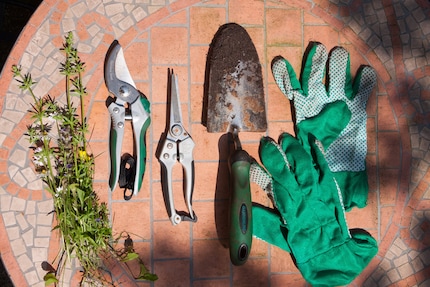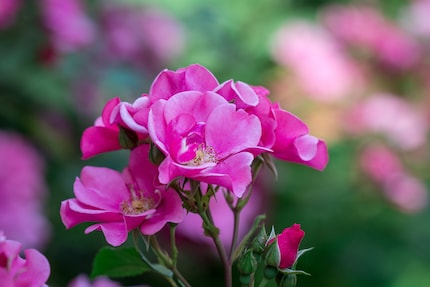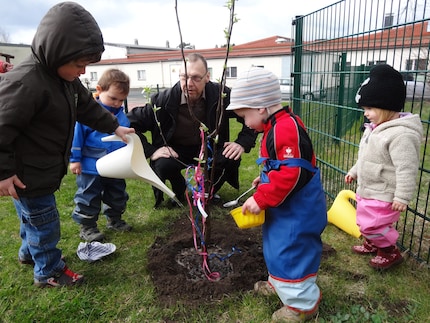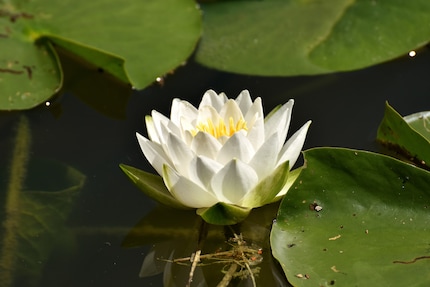
Background information
Tips for your strawberry garden (and your first vegetables)
by Andrea Rothenberger

The garden is awakening and there is a lot to do. There are roses and shrubs to cut back, the first woody plants to plant, the lawn to spruce up and the garden pond to clean. That's why I've summarised six tips on how to get your garden back on track quickly in spring.
If you have not yet cut back your perennials in autumn, you should now cut back the dry leaves and dry stems of the perennials. You can either put the material in the compost or use it to mulch the raspberries. Raspberries grow very well under a (not too thick) layer of mulch and therefore need much less watering in summer.
You need the right tools for pruning and planting perennials.Tip: It is best to cut back the roses when the forsythia is in bloom. The frost should have passed by then and the shoots have not yet emerged.
Properly pruned roses delight us with their blooms all year round.More information about roses: [[marketingpage:5057]]
March and April is planting time! Depending on the temperature and the weather, all perennials as well as berry and fruit plants can be planted in the garden. If there is still snow in March, I recommend waiting before planting. In general, the soil should already be slightly warmed up.
Exceptions are fruit, berry and hedge plants, which do not have a firm root ball and should be planted in the ground before they sprout. This can sometimes even be done in snow and ice. The prerequisite is that the ground is not completely frozen and a sufficiently large planting hole can be dug.
Planting a fruit tree in spring.Plants that you have bought in a pot are not affected by this. These can be planted almost all year round (provided the soil is frost-free). Remember to sprinkle in a good organic fertiliser when planting. This will provide the plants with sufficient nutrients during their growing season.
You should plant strawberries early in March if the weather conditions are good. This favours the growth of the young plants and you will get a small yield in the first year. However, planting in autumn is generally better, as you can then expect a full strawberry harvest the following year. Further tips for strawberry gardening:
Maintaining your lawn in spring is an important part of gardening in March. You can read my tips for lawn care here:
So that your garden pond can bloom and grow lushly in the new year, you should thoroughly clean the pond of dead plant parts and leaves in spring. Failure to do this will lead to an oversupply of nutrients in the water. This stimulates undesirable algae growth, which we naturally want to avoid. However, in a professionally designed pond, careful cleaning of the pond to remove dead material is usually enough to restore the pond's balance.
Spring maintenance is all the more important for a beautiful garden pond.If the pond becomes very "algaey" in spring despite good cleaning, a good filter system may be able to help. If this is still not enough, I recommend seeking advice from a pond specialist. In most cases, one of the external conditions is not right. For example, the pond is too shady, a large tree is constantly polluting the pond or unneeded nutrients are being drawn into the pond from the planted swamp section.
Don't have a pond yet? Then build your own pond in the garden. [[marketingpage:5728]]
Have fun gardening!
I discovered my love for gardening very early on and later turned my passion into my profession. For a few years now, I’ve been regularly writing blog posts and publishing articles in the HomeGardening section of myPfadFinder.com. This is where I give readers tips and tricks on gardens and balconies and present my latest gardening videos.
Find out more about me here: <a href="http://www.andreas-homegardening.com/" target="_blank">www.andreas-homegardening.com</a>
Interesting facts about products, behind-the-scenes looks at manufacturers and deep-dives on interesting people.
Show all
Depending on the weather, region or height, the timing of pruning must be adjusted. March is generally the very latest date for pruning roses, hydrangeas and many other spring-flowering ornamental shrubs
.
How much you need to cut back depends on the type of rose. With polyanthus roses or bedding roses, cut back to the rootstock if possible, but leave two to three eyes on the strong main stem. The eye or bud on which you cut (one centimetre above the bud) should always point outwards, i.e. away from the stock. Fine and weak shoots should be cut away so that the strength goes into the main shoot and the plant develops strong stems.

Larger trees and shrubs should mainly be pruned in the winter months of January and February. Hedges in summer or early autumn
.
As a general rule, trees and shrubs should not be pruned in March (except in commercial construction). This is for the simple reason of nature conservation, as many birds are already actively breeding in February, or March at the latest, and should not be disturbed during the breeding season so that they can give birth to their offspring in peace.



Ariel Universal+
72 Washing cycles, Washing powder